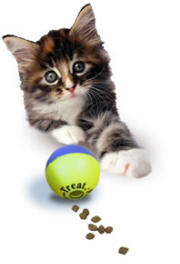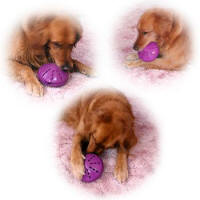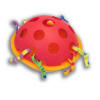Pets need, desire and benefit from daily
activity

There are many brands and types of food puzzles. It's best to offer a few puzzles with varying difficulty and then rotate what is offered daily to keep these toys interesting. Finally, some pet parents make their own food puzzles using PVC pipe or other improvisations. For cats try a tissue role or Kleenex box stuffed with paper and hide food inside. Then let them tear it up!
A “food puzzle” is any toy or object that can contain food and requires the pet to work to find a way to obtain the food. The most common food puzzle is a, “Kong” toy. Kongs can be filled with cheese, peanut butter, cheerios, kibble or a variety of many things. The goal is for the food to be released slowly and with some effort on the pet's part.
Filling a Kong with canned food and then freezing it is a good way to slow things down! Just beware of where you offer the food puzzle as carpets have been known to take the brunt of these feeding devices. Placing them in a kennel is ideal.
Pets need mental stimulation and something to do during the day when their people are gone. Wild Canids (wolves, dogs, foxes, etc.) spend about 60% of their day searching for food. Feeding an entire day’s food in 5 -10 minutes does nothing to encourage activity. Feeding from Food Puzzles allows hunger to be the motivation to play with the puzzle for hours, thus doing what nature intended.
Is it fair to frustrate your pet with a puzzle?
Because PEOPLE eat fast food, they think dogs should. But people still spend the day in mental and physical pursuit of the money to buy the food. Ideally, pets would spend about the same amount of time “working” for their food.
Does a pet become frustrated with a puzzle?
Sure. The same way a teenager becomes frustrated with a video game. In both cases, the intermittent reward keeps them engrossed and excited. Kongs and rubber toys with holes in them can be filled
with various soft or hard treats such as cheese,
bread, peanut butter, cheerios,
store bought treats stuffed
tightly with a larger biscuit to help block the opening. Start easy and work your way up to making it harder and harder for your pet to get food from the puzzle. Human
creativity in stuffing the food puzzle helps slow down the process
of getting the food out. The slower the better once the pet is
comfortable with puzzles. Have at least 3 different puzzles in different difficulty levels to rotate every day.
|
If
needed to get your
pet interested in a puzzle, smear
a little canned food or
peanut butter on the outside
of the puzzle. |
How to
introduce the first food puzzle
Do
not feed your pet for 24 hours before introducing the first puzzle.
Place a few hard or semi-hard fragrant treats
in the food puzzle to help attract initial interest.
You may need to show your pet that tasty rewards fall out. If your
pet is not interested smear canned food on the outside of the
puzzle. For dogs you can use peanut butter! Most puzzles are top
rack dishwater safe for easy clean up.
Once your pet will readily work to get treats out
change to their own kibble. Start each day with a measured
amount of food appropriate for your pet's weight. That will be the
allotment for the day to be placed in the puzzles.
Provide 80% of food in food
puzzles with the rest used for
hand feeding. Working on kennel training? Try placing one
puzzle in the kennel!
Ask your
veterinarian
Ask your veterinarian what type and how much food to feed you
pet for optimal health. Get any homemade food puzzles approved by
your veterinarian in advance. Some pets may consume cardboard pieces.
Benefits of Food Puzzles Summary
- Makes mealtime
stimulating,
unpredictable, and a way
to expend energy

- Hide them around the
house
- Vary the
difficulty
- Some are adjustable
- Need to be
customized to the dog's
weight and personality
- Start with easy and work
your way up to harder ones
|
When doing internet searches for
purchasing food puzzles look using the key words:
Food Puzzles, Interactive Puzzles, Treat
Delivery Device |
Tripp's Tips
Rotate at least
3 varieties of
puzzles daily.
If you are
kennel training,
place the puzzle
in the kennel to
associate it
with positive
surprises.
If you want a
positive
association with
the bath tub
(and an
easy-to-clean
solution) and if
your pet is a
size that works,
place puzzle in
the bathtub.
Puzzles can be
left when you
are not home or
any time you
need a
distraction.
Start each day
with a measured
amount of food
recommended by
the pet's
veterinarian to
avoid
overfeeding.
Decrease food by
the amount of
treats added.
Combination of
store bought and
home made.th="425" height="344">
|